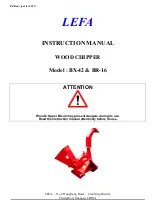
Page 77
English
Maintenance
9.7 Dehydrating filter
The refrigeration circuits are provided with dehydrat-
ing filters.
The filter clogging is marked by the presence of air
bubbles in the sight glass, or by the difference be-
tween the temperatures measured downstream from
and upstream of the drying filter. If, once the car-
tridge has been cleaned, there are still some air bub-
bles, the appliance has lost a part of the refrigerant
charge in one or more points, that must be identified
and serviced.
9.8 Sight glass
The sight glass is used for inspecting the refrigerant
flow and the humidity % of the refrigerant. The pres-
ence of bubbles indicates that the dehydrating filter
is clogged or the charge insufficient.
A colour indicator is positioned inside the sight
glass. If you compare the colour of the indicator to
the scale on the ring of the sight glass, you can calcu-
late the percentage of humidity of the refrigerant. If it
is excessive, replace the filter’s cartridge, operate
the appliance for 1 day and then check the humidity
% again. When the humidity % is within the pre-de-
termined range, no other operations are required. If
the humidity % is still too high, replace the dehydrat-
ing filter again, start the unit and operate it for anoth-
er day.
9.9 Thermostatic expansion valve
The circuit of the unit is equipped with a thermostatic
expansion valve, with external equalizer.
The valve is shop-calibrated for an overheating of
5°C.
Procedure to check for overheating:
– Measure the suction pressure with the pressure
gauges on the board of the unit o using a pressure
gauge connected to the service valve on the suc-
tion side.
– From the pressure gauge’s temperature scale, mea-
sure the saturated suction temperature (Tsa) which
corresponds to the pressure value.
– Using a contact pressure gauge affixed to the out-
let fitting of the gas of the evaporator, measure the
actual temperature (Tse).
Overheating calculation (S):
S = Tse - Tsa
Overheating is regulated through the thermostatic
expansion valve.
Make the adjusting screw follow a complete turn,
and operate the appliance for five minutes.
Check again and, if necessary, repeat the regula-
tion.
If the expansion valve cannot be regulated, it is prob-
ably broken, and shall be replaced. The replace-
ment must be carried out by a Service Centre.
9.10 Evaporator
Check at regular intervals that the water side of the
heat exchanger is perfectly clean. To do this, mea-
sure the pressure drop, water side (see Section 8) or
measure the temperature of the liquid leaving and
entering the heat exchanger, and compare it to the
evaporation temperature.
To obtain an effective heat exchange, the difference
between the temperature of the leaving water and
the saturated evaporating temperature must be in the
2 - 4°C range. A greater difference would indicate a
low efficiency of the heat exchanger (i.e. the heat ex-
changer is dirty).
In this case, the heat exchanger must be subjected to
chemical cleaning, an operation that shall be carried
out by authorised engineers.
For other maintenance operations (extraordinary
overhauling, replacement of the heat exchanger
etc.), contact an authorised Service Centre.
Manuale CLS-CLH2 7.2.2005 10:23 Pagina 77






































